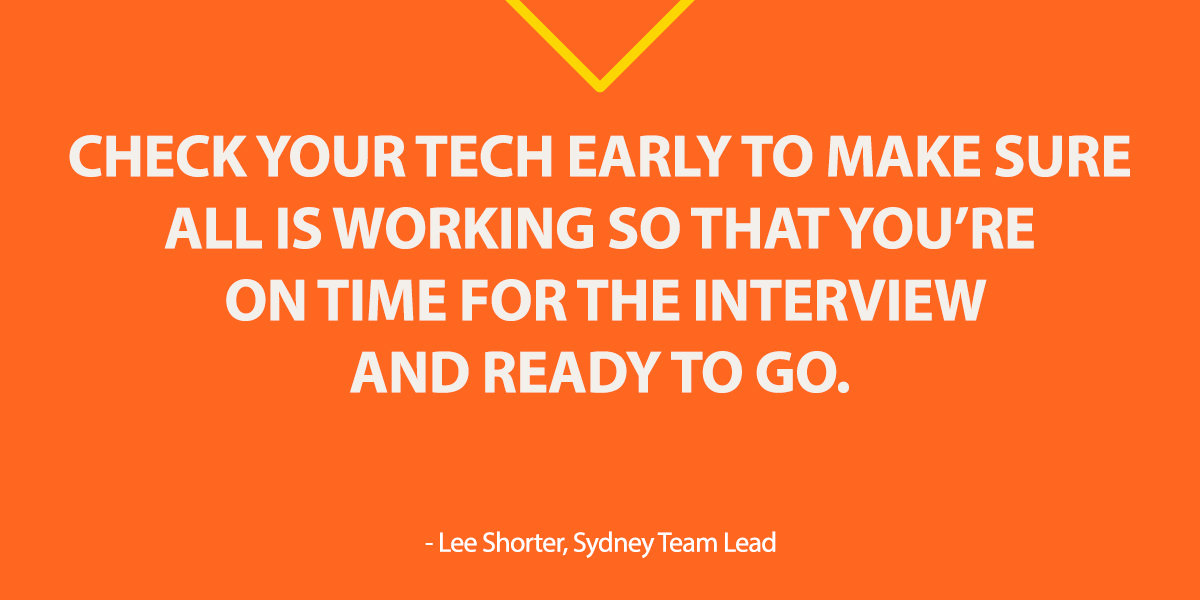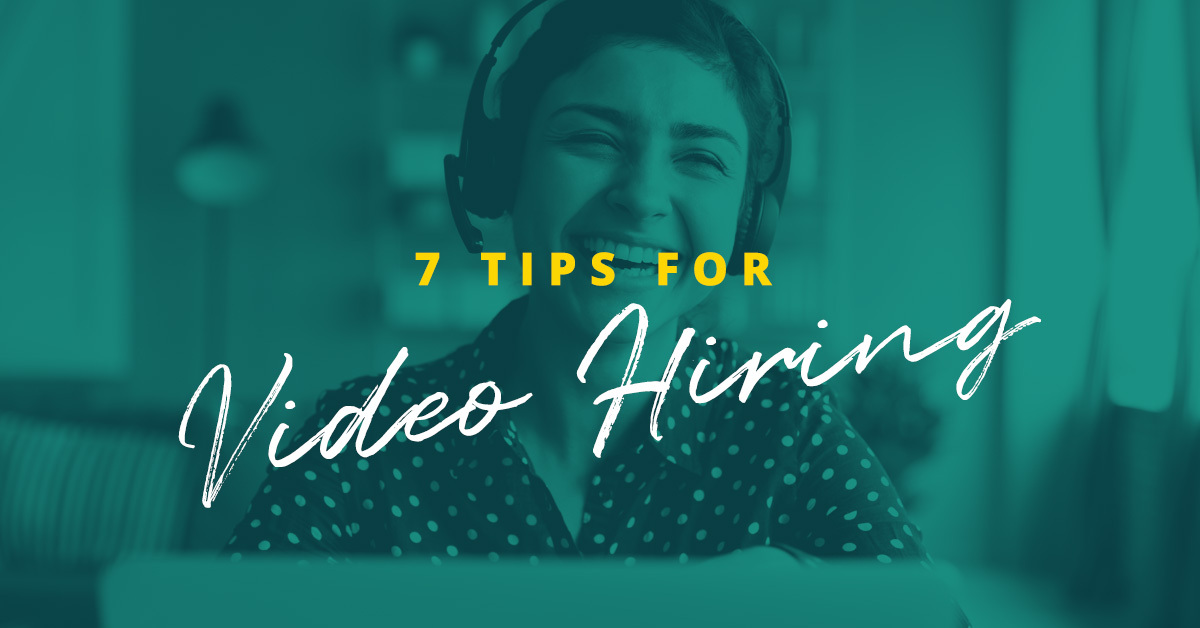In the middle of a global pandemic, it's hard to think about hiring. But precisely because so many organisations are changing the way they work, you might find yourself doing just that.
The tricky part is that the interview process, like everything else right now, is totally digital. How can you embrace the video interview? We talked to some of our recruiting pros to find out.
Social interviewing, emphasis on social
When you can't be face-to-face, a Google hangout or Zoom is the next best thing. Lee Shorter, our Aquent Team Lead in Sydney, says, “It's still the best available option for meetings right now. Certainly, when it comes to recruiting, it's far better to gauge someone's personality, traits, communication style and mannerisms when you can see them rather than interviewing over the phone.”
Rosie McAlister, our Talent Agent in Melbourne agrees. “I definitely think it would replace phone interviews as it gives the employer an opportunity to see the talent and watch their body language throughout the interview.”
Long before now, people were touting the benefits of video conferencing. Forbes found that 62% of executives said video improved communication and about half said it also improved the degree of understanding.

It also lets you see body language, which is key. Keep an eye out for 10 of the worst things a candidate can do, according to Forbes.
Get real
Locking eyes over your webcam is as real as it's going to get for now. So do what you can to earn your potential hire's trust. For starters, acknowledge that nothing about our current situation is typical. Much of the country is working from home and we have no idea exactly how things will change when we aren't anymore. (Virtual onboarding will most certainly be a thing for a lot of new hires.)
Candidates are looking for assurance. Communicate openly about the role and the state of your organisation. Kristen Ribero at the college recruitment and career management platform Handshake, says keeping candidates informed throughout the hiring process in personalised, empathetic ways can go far.
Lee Shorter adds, “candidates are usually excited by a challenge. If your business isn't doing so well, if product performance isn't quite there, if digital transformation still needs to happen, and if internal capabilities need to improve and expand — these are all ways to entice people to be part of the change. It's far better to be honest about the current state of play and attract people to facilitate growth, than to say everything is perfect and you're just here to keep the lights on.”
Watch for warning signs
What are the biggest indicators for our recruiters? Disinterest.
“Video interviews are a great way to establish whether or not the candidate is interested in the role and if they have taken the time to prepare”. Rosie also says “I also think it's important to outline the expectations of the interview and let the candidate know whether it will be a formal interview or if it's just a conversation”.
Lee states “Are they dressed appropriately? Have they taken themselves off to a quiet location, or do they have distractions in the background? Does their body language suggest a level of interest or disinterest?”
And JobScan points out that, “In a face-to-face meeting, distractions are shared, so both the interviewer and the candidate break from the conversation at the same time. But in a Zoom interview, the hiring manager won't know that there's a knock at the door or an email notification on someone's screen.” Zero in on the interviewees that know how to focus.
Glitch-proof ahead of time
We've all been there. Your meeting is about to start and you can't get on — maybe you don't have the software downloaded, something is wrong with your camera, or your WiFi is terrible because it's raining. For interviews, the stakes are much higher on both sides of the table. So our recruiters say to be proactive instead of reactive.

A tip from Lee is, “If you try the meeting link for the first time one minute prior to the allocated time, chances are you'll need to download software and will be late to the meeting. Try to do so around 5-10 minutes prior to the meeting start time so that you can ensure you're on time and your video and audio is working.” The same advice applies to hiring managers as well. Check your tech early to make sure all is working so that you're on time for the interview and ready to go.
Look the part
Remote working often means that people do not dress in the same way as they would if they were going into the office. However for job interviews happening remotely, it is critical that people dress as they would for a face-to-face meeting.
In her 10 Tips for a Successful Interview, Katie Heinz says, “Dressing as you would in the office gives a sense of your culture.”
Pro tip: Avoid busy patterns which can look wonky on screen.
Avoid culture shock
How can you sell company culture when candidates can't check out the neighbourhood, stroll through the cubes, or suss out the kitchen snack situation? It's not ideal since 82% of hiring managers say culture fit is important.
“It can be hard to show the office setting if offices are closed, but candidates are going to want to know about the culture and environment they'd be going into”. Lee suggests that when describing the team set-up, don't just think about the org structure. How do teams interact? Where are they positioned in the office and how does this enhance or affect productivity? Will this person be interacting with anyone not based in the same location and how will they connect? Relationships create a culture within organisations so all of this information is equally as important as whether or not you have a ping pong table and organise Friday drinks.
Plus, have questions in mind to see if your interviewee will mesh with your team—like how past coworkers would describe them, what environment they thrive in or what management style they prefer. (Our blogs can help, like 14 Best Interview Questions for Creatives and 7 Non-Technical Skills Your Creative Candidates Should Have.)
Consider the background of your video
It's amazing how we can actually forget we're on video while we're on video. (We've all seen things we wish we hadn't on these calls.) Yes, it's harder to do when there are only two people in the meeting, but our recruiters say think big picture.
In these times, people understand a cat or a toddler might wander through. But as Rosie says “It all comes down to building a relationship with your candidate and everyone is working from home, so I don't think anyone would have an expectation of a corporate background“.
“However how does the video background look and what does it say about you as a person?,” cautions Lee. “If you're in your bedroom with piles of dirty clothes on display and an unmade bed, do you think this will come across well or look like you're disorganised? Think about the appearance of everything on the screen and how it can affect the way you're perceived.
You are now ready to dominate the video interview and hire your superhero candidates. Who knows, maybe we'll want to keep this up after we're back at the office? After all, it's bringing out our creativity in whole new ways, like this Aussie's customised background of him walking into his own meeting.
Latest.

Everything you need to kickstart your freelance career.
Job Seeker, Here to help

In an AI-driven world, humans are still irreplaceable.
Thought Leadership, Industry Trends

Maximising your team performance with competitive salaries.
Job Seeker, Industry Trends

